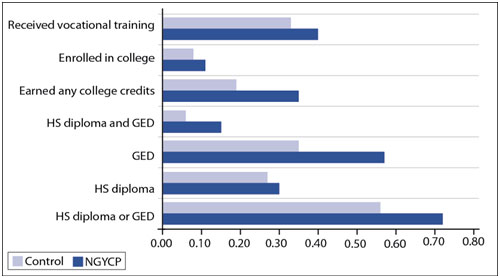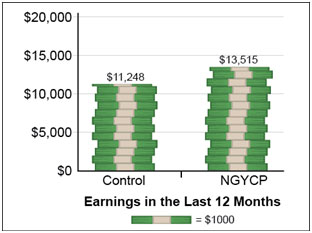The National Guard Youth ChalleNGe Program (NGYCP) began in the early 1990s to equip at-risk youth with the skills and training to have successful adult lives. To be eligible, youth must be 16 to 18 years of age, have dropped out of or been expelled from school, be unemployed, not be drug users, and not be heavily involved in the criminal justice system.
Research provides strong evidence that NGYCP improves the educational outcomes of at-risk youth.
A well-conducted randomized controlled trial demonstrated that the NGYCP resulted in statistically significant improvements in educational outcomes measured 9 months, 21 months, and 3 years after random assignment. For instance, 72 percent of NGYCP youth earned a high school diploma or GED by 3 years after random assignment, compared with 56 percent of control group youth (Exhibit 1).
Exhibit 1: Educational attainment of NGYCP and control group youth 3 years after random assignment

Note: All differences are statistically significant at the 5-percent level.
There is also strong evidence that NGYCP improves the labor market outcomes of at-risk youth.
Three years after random assignment, NGYCP youth were more likely to be employed (58 versus 51 percent) and had worked one more month in the past year than control group members. They also had higher average annual earnings (Exhibit 2).
Exhibit 2: Earnings of NGYCP and control group youth 3 years after random assignment

A cost-benefit analysis found NGYCP produced large positive benefits.
In a well-conducted cost-benefit analysis, Perez-Arce et al. (2012) determined that, from the perspective of society as a whole, the NGYCP produced net benefits of $25,549 per admittee, a return on investment of 166 percent. The government incurred negative net benefits, largely due to covering the bulk of the operating costs, and NGYCP participants had large, positive net benefits.
NGYCP is a multi-component intervention, with little evidence on the effectiveness of specific components.
Research has not examined whether particular components of the NGYCP—such as the Residential phase, the military-style discipline, or the Youth Initiated Mentoring (YIM)—are responsible for the program’s impacts. Descriptive research (Schwartz et al. 2013) suggests that youth who had longer mentoring relationships were more likely to have positive long-term outcomes, and that mentors provided participants with valuable social-emotional support, guidance, and practical assistance that contributed to their successful program completion (Spencer et al. 2013). However, the research has not established the causal impact of YIM.
Features of the National Guard Youth ChalleNGe Program
The 17-month program consists of a two-week Pre-Challenge phase, a 20-week Residential phase, and a one-year Post-Residential phase.
Participants live in barracks-style housing (sometimes on a military base) in a very disciplined environment during the first two phases. They wear their hair short, are referred to as cadets, and wear military uniforms.
In the Pre-Challenge phase, participants are oriented to the program’s rules and begin physical training.
During the Residential phase, they participate in various activities addressing eight core pillars: leadership/followership, responsible citizenship, service to community, life-coping skills, physical fitness, health and hygiene, job skills, and academic excellence. They spend most of their time in an educational component that is usually geared toward receiving a General Educational Development (GED) certificate.
During the Post-Residential phase of the program, after participants are placed in employment, education, or military service, they continue to receive structured mentoring.
